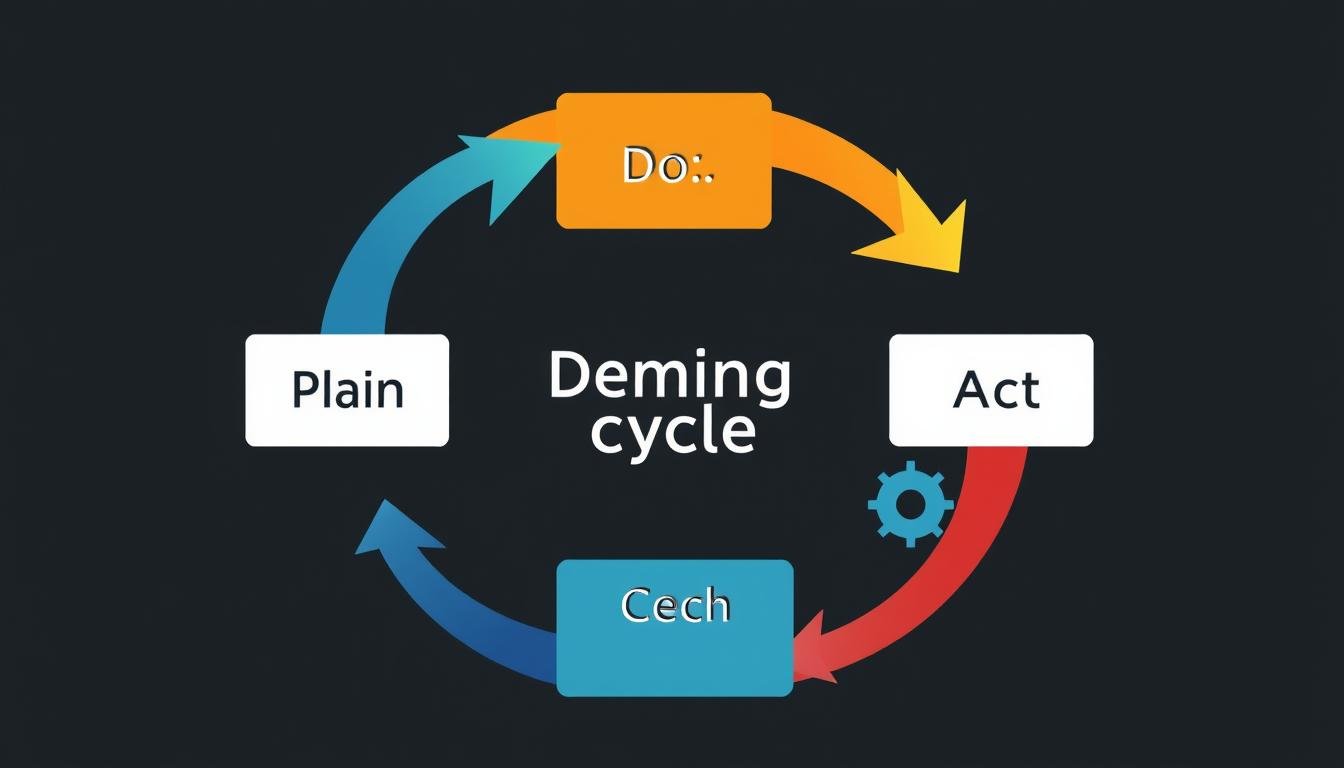The Deming Cycle (PDCA): Continuous Improvement
Have you ever wondered why some companies always do better than others? It might be because they use The Deming Cycle (PDCA). This Continuous Improvement Model changes how businesses work. It was first made by physicist Walter Shewhart and later improved by W. Edwards Deming.
This Quality Management Method focuses on solving problems step by step. It helps companies stay ahead in a changing market.
The PDCA Cycle has four main steps: Plan, Do, Check, and Act. These stages help companies make smart changes based on data. We’ll look into its history, compare it with other methods, and see how it works in different fields like manufacturing and healthcare.
Key Takeaways
- The PDCA Cycle promotes continuous iteration for ongoing improvements.
- Developed by W. Edwards Deming, it is essential for quality control.
- The Deming Cycle encourages critical thinking and problem-solving.
- Rooted in the scientific method, it aims for both major breakthroughs and incremental improvements.
- Its implementation can significantly enhance project performance and business outcomes.
Introduction to Continuous Improvement Models
Continuous improvement is key in today’s business world. It helps companies grow and change. By focusing on making things better, companies can improve their products and services. This approach also boosts innovation, letting businesses meet new market needs and customer wants.
Importance of Continuous Improvement in Business
Continuous improvement is vital in today’s fast-paced world. Companies that focus on it can see big benefits. These include:
- Enhanced operational efficiency
- Reduced waste across processes
- Greater customer satisfaction
- Improved employee engagement
Using tools like the PDCA Cycle helps businesses set clear goals for improvement. This cycle is a key process. It helps set targets, make changes, and check results.
Overview of Key Concepts in Quality Management
Quality management is all about making organizations better. It focuses on continuous improvement. Important ideas include:
- PDCA Cycle – A four-stage process: Plan, Do, Check, and Act.
- Data-Driven Decision Making – Using data to make smart choices.
- Innovation – Encouraging new ideas to improve processes and products.
- Business Process Improvement – Making processes better for better results.
Adding these ideas to a culture of continuous improvement brings lasting benefits. It makes the whole organization stronger.
The Deming Cycle (PDCA): An Overview
The Deming Cycle, also known as the PDCA Cycle, is a key framework for ongoing improvement. It focuses on a cycle of learning, making it essential for those aiming for top performance. The Historical Context of PDCA begins with Walter Shewhart’s work in the 1920s. This work led to the PDCA Cycle, popularized by W. Edwards Deming in the 1950s. Today, the Deming Wheel is a vital tool, especially in Total Quality Management.
Definition and Historical Context
The PDCA Cycle has four main steps: Plan, Do, Check, and Act. Each step is designed to help improve quality continuously. This model became widely used in many industries, starting with the automotive sector. Toyota adopted Total Quality Management in the 1950s, making the PDCA Cycle a key tool for improvement.
Comparison with Other Quality Improvement Frameworks
The PDCA Cycle is unique among Quality Improvement Frameworks like Six Sigma and Total Quality Management. It focuses on ongoing improvement rather than quick fixes. While similar to the PDSA Cycle, Deming’s approach emphasizes detailed evaluation during the checking phase. This makes the PDCA Cycle flexible for various projects but less suitable for urgent issues.
| Aspect | PDCA Cycle | Other Frameworks |
|---|---|---|
| Focus | Iterative Processes | One-Time Fixes |
| Origin | Shewhart’s Cycle | Various Sources |
| Flexibility | High | Variable |
| Application | Various Industries | Specific Use Cases |
| Time to Results | Gradual | Quicker in Some Methods |
Understanding the Four Stages of the PDCA Cycle
The PDCA Cycle Stages are key for ongoing improvement in organizations. They use the Plan-Do-Check-Act model to make sure processes are always getting better. Each step is vital for finding and fixing problems, leading to better results.
Plan: Setting Objectives and Identifying Improvements
In the Plan stage, we focus on finding challenges and setting clear goals. Tools like the Ishikawa diagram and the 5 W’s help us understand problems better. This stage lays the groundwork for successful changes, making sure everyone knows what needs to be improved.
Do: Implementing Changes and Process Adjustments
During the Do phase, we put our plans into action. We carry out the solutions and adjust processes as needed. It’s important to stick to timelines and use resources well to meet our goals.
Check: Analyzing Results and Learning from Outcomes
The Check stage is all about seeing how well our changes worked. We look at the difference between what we expected and what happened. This helps us learn from both successes and failures. The data we collect helps us plan better for the future.
Act: Standardizing Improvements and Preparing for Next Cycle
In the Act stage, we review what worked and what didn’t in the Check phase. We make sure to keep the good changes in our daily work. The insights we get help us get ready for the next PDCA cycle, keeping us improving all the time.
| Stage | Focus | Key Tools | Outcome |
|---|---|---|---|
| Plan | Setting objectives and identifying improvements | Ishikawa diagram, 5 W’s | Clear action plan |
| Do | Implementing changes | Team training, resource allocation | Execution of solutions |
| Check | Analyzing results | Performance metrics, feedback sessions | Identified variances |
| Act | Standardizing improvements | Documentation, follow-up strategies | Ongoing operational enhancements |
Benefits of Implementing the Deming Cycle in Organizations
Organizations that use the Deming Cycle, or PDCA, see big benefits. These benefits make their work better. They help create a mindset for ongoing improvement and lasting success. The PDCA cycle helps improve quality and consistency in what they make and do. It also helps them stay innovative and adaptable.
Enhanced Quality and Consistency in Products and Services
The PDCA cycle makes things better by constantly checking and tweaking processes. This helps get rid of waste and mistakes. It makes sure products and services meet and beat what customers want.
Using the PDCA leads to better planning and documented steps. This means happier customers in the end.
Fostering a Culture of Innovation and Adaptability
The PDCA cycle encourages innovation in companies. It lets employees try new things, learn from mistakes, and work together to solve problems. This makes teams flexible and ready to handle changes or challenges.
Companies that adopt this culture see innovation as a constant journey. This helps them grow and succeed over time.
Real-life Examples of PDCA in Action
Many companies have made big strides by using the PDCA cycle. For example, manufacturing firms have cut down on mistakes by improving their processes. Service companies have made customers happier by using the PDCA to find ways to do better.
These examples show how the PDCA cycle can really change things for the better in different fields.
Conclusion
The Deming Cycle, also known as PDCA, is key for any company aiming for ongoing improvement. It has four steps: Planning, Doing, Checking, and Acting. This cycle helps organizations improve by making them learn and adapt quickly.
PDCA works well in many areas, like project management and improving supply chains. It helps make things more efficient and gets teams working together better. This cycle keeps going, letting teams try out new ideas to solve problems. This leads to smarter decisions and better use of resources.
As businesses change, using PDCA gives a big edge. Companies that use the Deming Cycle see lower costs, higher profits, and happier customers. Making continuous improvement a part of their culture helps them stay ahead. It’s not just a good idea; it’s what they do every day.
Source Links
- PDCA
- William Edwards Deming in the World of Six Sigma
- How to Use The Deming Cycle for Continuous Quality Improvement
- Continuous Improvement 101: The Deming Cycle | Stratex hub
- Continuous Improvement 101: The Deming Cycle (PDCA)
- What Is the PDCA Cycle (Plan Do Check Act Methodology)? – Tervene
- Deming Cycle: Plan-Do-Check-Act (PDCA) Cycle Explained
- What is the Plan-Do-Check-Act (PDCA) Cycle? [2024] • Asana
- The 4 stages of the Deming wheel
- PDCA Cycle Explained: 4 Steps for Continuous Learning and Improvement | Productivity & Positivity
- How to Apply the Plan-Do-Check-Act (PDCA) Model
- Business Enterprise Mapping | BEM Insights
- Benefits of using the Plan-Do-Check-Act (PDCA) Cycle for Continuous Improvement
- Applying the PDCA cycle
- How PDCA Can Help Improve Organizational Efficiency
- Your Guide to The Deming Cycle (or PDCA)







